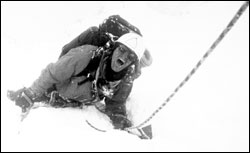As the only mountain climber among Seattle’s pallid community of film critics, I’m probably in the best position to judge Touching the Void (which opens Friday, Jan. 23, at the Egyptian). It’s an adaptation of Joe Simpson’s award-winning 1988 account of a Peruvian climbing expedition that went very, very badly. Everyone who climbs has read itVoid is considered a classic among mountaineering literature. The movie is a different matter. Simpson and his partner, Simon Yates, both appear in the film, speaking separately before the unblinking lens in the manner of an Errol Morris documentary. This footage is great: two different, prickly personalities frankly discussing a near-fatal calamity that changed both their lives.
Yet this Void is part doc, part re-enactment, and the other footage of two actors tromping through the snow and ice is more problematic. It’s not particularly bad, like Vertical Limit, nor is it particularly good, like The Eiger Sanction (to name two prominent titles in the tiny genre of mountaineering films). It’s just awkward sandwiched between Simpson and Yates. But, fortunately, here is a case of story winning out over storytelling: Whatever its narrative deficiencies, Void is a film that is both gripping and harrowing because it’s real. You can’t believe these two guys lived to tell their taleand what a tale it is.
The two young English alpinists set out to tackle the unclimbed West Face of Siula Grande in the Peruvian Andes in 1985. It’s a range known for rotten, unstable snow and bad weather, and they both now admit they were a little over their heads. They were also alonesave for a trekker, Richard Hawking, whom they met along the way, and who would wait in base camp for their return. The three-day ascent goes quickly: We see actor Joe (Brendan Mackey) and actor Simon (Nicholas Aaron) plodding through scree and crevasses; then their climbing doubles scale vertical ice (actually in the Alps); periodic long shots taken at Siula Grande reveal its awesome mass and menace.
However, the real Simpson warns, “80 percent of accidents happen on descents.” (We also hear from him and Yates in voice-over during the restaged sequences. The actors have very few linesmainly grunting and yelling.) True enougha storm hits, forcing the climbers off route. Then Simpson loses purchase, falls, and shatters a leg. In his wonderful, nasal Brit accent, Yates recalls thinking, “We’re stuffed.” As in dead.
NOW THE STORY BEGINS. What we climbers call “epic” doesn’t generally mean success, but its oppositewhen everything goes wrong, when everything takes too long, when people get hurt and cold and miserable. Void is an epic. Yates valiantly sticks by his injured buddy when a colder man might walk away to save himself (yes, there are precedents). So he lowers Simpson, screaming in pain, by rope through the dark night, his own fingers turning black with frostbite. They’re out of water and food. Things look bad; then they get even worse.
For those who haven’t read the book, I won’t give away the rest of the ordeal; obviously both men survived. But it’s how they survived, separately, that matters. It took a long time for Void to reach the screen; at one point, a fictionalized version starring Tom Cruise was discussed. Better that it should wait and follow Shackleton-mania and Into Thin Air, since now the cubicle-dwelling public is primed and prepared for real-life survival tales. (“There’s not a lot of risk left in our lives,” notes Yates.) Remember, too, that Simpson and Yates set out on their trip long before reality-TV stunts and gimmicks made simulacra of real peril. If they were to die, no one would be there to watch.
Meanwhile, back in camp, one of the nice improvements on Simpson’s book is the comic relief provided by bumbling, uncomprehending, cheerful Richard, who’s played by an actor in the re-created scenes and appears as himself in studio sequences. Since Richard is a surrogate for the average urban moviegoer, the film could’ve used more of him. It also could’ve used less of the subjective camera work that’s supposed to depict Simpson’s subsequent hallucinations and wandering, but this device passes with his delirium.
IT’S ALMOST IMPOSSIBLE to explain to a non-climber that little pit of nausea in your stomach when you rope up for a steep and committed pitch. Ability aside, so many things can go wrongweather, rock and ice fall, gear failures, a tiny slip, a moment’s loss of concentration. Nineteen years later, Simpson recalls the exact sound and sequence of his ice tools coming unstuck while he backed down the short, vertical step that was his undoing.
Yet Void succeeds in communicating what it’s like to climb better than any film in recent memory. Climbers love to gossip and talk, and Simpson and Yates are both good talkers (and also both authors)you’d happily share a few pints with these two. The picture also benefits from the terrific editing of director Kevin Macdonald (whose 2000 documentary on the 1972 Olympic massacre, One Day in September, earned an Oscar). Real and substituted locations are well stitched together; the aerial photography over Peru is quite breathtaking; scenes inside a crevasse are frighteningly, realistically cold and lonely. (I’ve been there; I know.) Viewers will also get a sense of the beauty and exhilaration of gaining what I like to call the privileged view: Everything looks different from on high.
“We climb because it’s fun,” says Simpson, but we also climb for that little pit of nauseaor, more specifically, to cope with it. So how did he cope with almost unimaginable adversity? “You’ve gotta make decisions, even if they’re wrong. If you stop making decisions, you’re stuffed.” It’s a lesson that applies at sea level, too.








